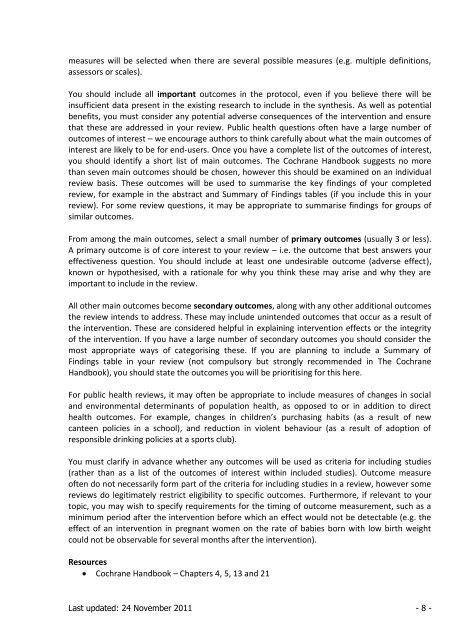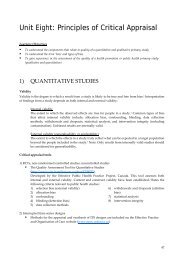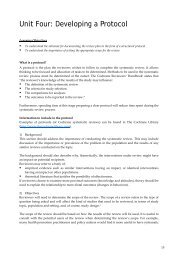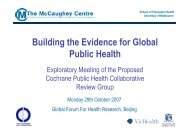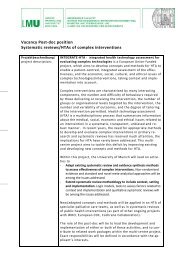Guide for Developing a Cochrane Protocol - Cochrane Public Health ...
Guide for Developing a Cochrane Protocol - Cochrane Public Health ...
Guide for Developing a Cochrane Protocol - Cochrane Public Health ...
You also want an ePaper? Increase the reach of your titles
YUMPU automatically turns print PDFs into web optimized ePapers that Google loves.
measures will be selected when there are several possible measures (e.g. multiple definitions,<br />
assessors or scales).<br />
You should include all important outcomes in the protocol, even if you believe there will be<br />
insufficient data present in the existing research to include in the synthesis. As well as potential<br />
benefits, you must consider any potential adverse consequences of the intervention and ensure<br />
that these are addressed in your review. <strong>Public</strong> health questions often have a large number of<br />
outcomes of interest – we encourage authors to think carefully about what the main outcomes of<br />
interest are likely to be <strong>for</strong> end-users. Once you have a complete list of the outcomes of interest,<br />
you should identify a short list of main outcomes. The <strong>Cochrane</strong> Handbook suggests no more<br />
than seven main outcomes should be chosen, however this should be examined on an individual<br />
review basis. These outcomes will be used to summarise the key findings of your completed<br />
review, <strong>for</strong> example in the abstract and Summary of Findings tables (if you include this in your<br />
review). For some review questions, it may be appropriate to summarise findings <strong>for</strong> groups of<br />
similar outcomes.<br />
From among the main outcomes, select a small number of primary outcomes (usually 3 or less).<br />
A primary outcome is of core interest to your review – i.e. the outcome that best answers your<br />
effectiveness question. You should include at least one undesirable outcome (adverse effect),<br />
known or hypothesised, with a rationale <strong>for</strong> why you think these may arise and why they are<br />
important to include in the review.<br />
All other main outcomes become secondary outcomes, along with any other additional outcomes<br />
the review intends to address. These may include unintended outcomes that occur as a result of<br />
the intervention. These are considered helpful in explaining intervention effects or the integrity<br />
of the intervention. If you have a large number of secondary outcomes you should consider the<br />
most appropriate ways of categorising these. If you are planning to include a Summary of<br />
Findings table in your review (not compulsory but strongly recommended in The <strong>Cochrane</strong><br />
Handbook), you should state the outcomes you will be prioritising <strong>for</strong> this here.<br />
For public health reviews, it may often be appropriate to include measures of changes in social<br />
and environmental determinants of population health, as opposed to or in addition to direct<br />
health outcomes. For example, changes in children’s purchasing habits (as a result of new<br />
canteen policies in a school), and reduction in violent behaviour (as a result of adoption of<br />
responsible drinking policies at a sports club).<br />
You must clarify in advance whether any outcomes will be used as criteria <strong>for</strong> including studies<br />
(rather than as a list of the outcomes of interest within included studies). Outcome measure<br />
often do not necessarily <strong>for</strong>m part of the criteria <strong>for</strong> including studies in a review, however some<br />
reviews do legitimately restrict eligibility to specific outcomes. Furthermore, if relevant to your<br />
topic, you may wish to specify requirements <strong>for</strong> the timing of outcome measurement, such as a<br />
minimum period after the intervention be<strong>for</strong>e which an effect would not be detectable (e.g. the<br />
effect of an intervention in pregnant women on the rate of babies born with low birth weight<br />
could not be observable <strong>for</strong> several months after the intervention).<br />
Resources<br />
<strong>Cochrane</strong> Handbook – Chapters 4, 5, 13 and 21<br />
Last updated: 24 November 2011 - 8 -


